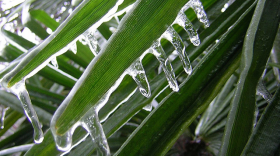
With the Wild Things
Weekdays @ 7:20 AM

With the Wild Things is a one-minute look at a particular environmental theme hosted by wildlife biologist Dr. Jerry Jackson. Produced by WGCU Public Media. Dr. Jackson takes you through your backyard, and Southwest Florida’s beaches, swamps and preserves to learn about “the wild things”.
With the Wild Things was previously funded by the Environmental Education Grant Program of the Florida Fish and Wildlife Conservation Commission.
Latest Episodes
-
Pigeons and Doves are members of the same family – Columbidae – and the names “pigeon” and “dove” have little relevance. Those we call “pigeons” are generally larger than those we call doves. Pigeons and doves occur on every continent and many islands and about 300 living species of pigeons and doves are known.Seven species are regularly found in Florida -- five are native; two are introduced. Others are occasionally seen. One – the Passenger Pigeon – was known from Florida, but now extinct.
-
Animals in south Florida don’t have to worry much about winter cold – and indeed many migrants from areas farther north find suitable living conditions here. But, a trip to the beach or on a rare blustery day sometimes makes one wonder. How do ducks, herons, egrets, and other birds tolerate wading or swimming in cold weather? Aquatic birds, for example, have bare skinny legs with leg muscles placed among insulating feathers.Blood vessels going to and from the very few muscles in the legs and feet lie right next to one another, and cold blood going back into the body is warmed by warmer blood coming from the body – and is nearly the same temperature as the blood circulating in the well-insulated body.
-
-
If asked “What plant best symbolizes the winter season?”, most people might say “Christmas trees”, but a fair number might instead suggest holly. Several species of holly are native to North America. Most are evergreen, have thick, somewhat shiny leaves that are resistant to colder climates, and are bordered and tipped with sharp points that protect the leaves from winter plant “munchers”, and in winter bear small red fruits that add to their winter holiday appeal. The fruits are eaten by many bird species and the seeds inside the fruits are deposited with a bit of fertilizer to begin growth in the spring. Some holly species grow into large trees.
-
New World Warblers are often referred to as the “butterflies of the bird world” – a designation because of their small size and diverse colors and patterns. A few warblers nest in south Florida, but several -- including the Palm Warbler, Yellow-rumped Warbler, and Black-and-white Warbler are common winter residents.These three have distinctive plumage patterns and behaviors, making them a great trio to begin exploring the diversity of warblers that pass through on migration. Beware, however: watching warblers as they flit among the branches of tall trees in search of insects can be addictive – and lead to a temporary affliction commonly known among birders as “warbler neck”.
-
Little Blue Herons are medium in size among herons – bigger than a Green Heron, but much smaller than a Great Blue Heron. The “blue color” of adults often tends towards gray and it helps them blend in with their aquatic environment. This heron is unusual in that its juvenile plumage is all white – a characteristic that allows it to blend in with other white birds – which it readily does, thus gaining “group” protection from potential predators and access to food resources found by the other species. Adults are much more solitary.
-
Wild Turkeys are birds that most of us know on sight because of their large size, habit of foraging in groups in relatively open areas, and the display of a male with his tail held up and fanned. Of course we know them because of their prominence at our holiday dinner tables – and in holiday advertising -- especially at Thanksgiving.
-
Molt is defined as the routine loss and replacement of feathers. It can occur at any time of year, but in most birds a complete molt occurs in late summer and fall and a partial molt may occur in early spring.The timing of each molt is important. In late summer and fall, there is generally an abundance of insects, seeds, and fruit that provides the energy for molt. This molt provides birds with fresh plumage and often colors and patterns that help conceal it in winter environments.
-
Gray Catbirds are in a bird family known as the “Mimidae” – because they mimic other birds, other animals, and even mechanical sounds. Other members of their family in Florida include the Brown Thrasher and the Northern Mockingbird – two excellent mimics that we often see and hear year-round as they feed, sing, and nest in relatively open vegetation. They often mimic the vocalizations of other bird species and it has been suggested that their mimicry may send the message that the area is crowded – and cause other birds to search for food elsewhere.
-
Adult Thorn Bugs are half-inch long insects that are “true bugs” (members of the insect Family Membracidae). They are native to South America, Central America, and many tropical islands. As with other members of this family, Thorn Bugs have sucking mouthparts that allow them to pierce plant tissues and drink plant sap. As a result, Thorn Bugs can cause the death of some twigs and potentially introduce diseases to the plant. However, in most cases, Thorn Bug populations are very low and damage caused by thorn bugs is minimal. The good news is that these insects do not feed on most native North American trees. Thorn bugs are an exotic invasive species in Florida that was likely introduced long ago along with an exotic tree species such as the Earleaf Acacia.Even today these insects feed primarily on exotic invasive trees and shrubs imported from tropical areas.










